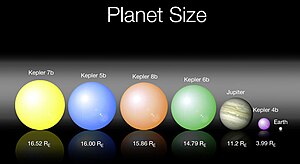Kepler-4b
Template:Planetbox begin Template:Planetbox image Template:Planetbox star Template:Planetbox character Template:Planetbox orbit Template:Planetbox discovery Template:Planetbox end
Kepler-4b, initially known as KOI 7.01, is an extrasolar planet first detected as a transit by the Kepler Mission. Its radius and mass are similar to that of Neptune; however, due to its proximity to its host star, it is substantially hotter than any planet in the Solar System. [1][2] The planet's discovery was announced on January 4, 2010 in Washington, D.C. alongside the other four planets that the Kepler spacecraft had confirmed by that point after being confirmed by telescopes at the W.M. Keck Observatory.
Nomenclature and history
Kepler-4b was named because it was the first planet discovered in the orbit of its star, Kepler-4. Kepler-4 was, in turn, named for the Kepler Mission, a NASA satellite whose purpose is to discover Earth-like planets in a section of the sky between constellations Cygnus and Lyra using the transit method, where small and steady decreases in a star's brightness are measured as a planet crosses in front of it.[3] Initially, Kepler-4b was detected as a transit event by the Kepler telescope and considered a Kepler Object of Interest with the designation KOI 7.01.[4]
Subsequent radial velocity measurements by the High Resolution Echelle Spectrometer on the telescopes of W.M. Keck Observatory confirmed the planetary nature of the transit event and established a mass estimate for the planet. [5] The planet's existence was announced on January 4, 2010 along with four other planets detected by Kepler: Kepler-5b, 6b, 7b and 8b[1] at the 215th meeting of the American Astronomical Society in Washington, D.C.[6]
Host star
Kepler-4 is located within the Draco constellation on the sky, and is approximately 550 parsecs from out solar system. It has an effective temperature almost identical to the Sun at 5857 Kelvin, but a mass and radius that are somewhat larger than the sun: 1.223 and 1.487 . The star is thought to be around 4.5 billion years old, and at or very near the end of its main-sequence hydrogen burning phase. In several tens of millions of years it will likely become a subgiant star. [5]
Characteristics
Kepler-4b orbits its host star in 3.213 days at a distance of 0.046

See also
References
- ^ a b Ron Cowen (2010-01-04). "Kepler space telescope finds its first extrasolar planets". Science News. Retrieved 2010-01-04.
- ^ "Summary Table of Kepler Discoveries". NASA. 2010-03-15. Retrieved 2010-03-18.
- ^ "Kepler: About the Mission". Kepler Mission. NASA. 2011. Retrieved 11 March 2011.
- ^ Borucki, William J; et al. (2011-02-01). "Characteristics of planetary candidates observed by Kepler, II: Analysis of the first four months of data" (PDF). http://kepler.nasa.gov. Retrieved 2011-03-07.
{{cite web}}: Explicit use of et al. in:|author=(help); External link in|publisher= - ^ a b c d
Borucki, William J.; et al. (2010-01-04). "Kepler-4b: A Hot Neptune-like Planet of a G0 Star Near Main-sequence Turnoff". http://arxiv.org. Retrieved 2011-03-07.
{{cite web}}: Explicit use of et al. in:|author=(help); External link in|publisher= - ^ Rich Talcott (5 January 2010). "215th AAS meeting update: Kepler discoveries the talk of the town". Astronomy.com. Astronomy magazine. Retrieved 11 March 2011.
{{cite web}}: Italic or bold markup not allowed in:|publisher=(help) - ^ Kipping, David M; Bakos, Gaspar A (2011-01-04). "An Independent Analysis of Kepler-4b through Kepler-8b". http://arxiv.org. Retrieved 2011-03-07.
{{cite web}}: External link in|publisher=
External links
![]() Media related to Kepler-4 b at Wikimedia Commons
Media related to Kepler-4 b at Wikimedia Commons


